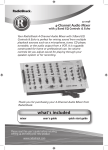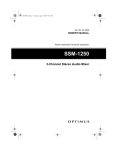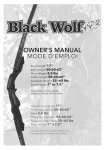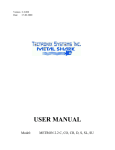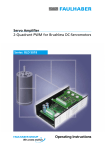Download Radio Shack 32-3001 Owner`s manual
Transcript
32-3001.fm Page 1 Tuesday, August 10, 1999 8:02 AM Cat. No. 32-3001 OWNER’S MANUAL Please read before using this equipment. SM-1000 Audio Mixer with Echo (Rack Mount Type) 32-3001.fm Page 2 Tuesday, August 10, 1999 8:02 AM FEATURES Your Radio Shack SSM-1000 Audio Mixer with Echo is a sophisticated control center for recording from multiple playback sources such as a CD player, tuner, turntable, or VCR, or from live performances. A seven band equalizer and an echo effect are incorporated into the mixer so you can tailor the sound to compensate for environmental conditions or for personal preference. The mixer’s many features give you almost limitless sound combinations. Its features include: 7-Band Frequency Equalizer — allows you to tailor the sound output to your preference. Two Pairs of Stereo PHONO Inputs — for using turntables with either magnetic or ceramic cartridges. Stereo Line Inputs — let you connect most high level audio sources, such as a tape deck, amplifier, tuner, or VCR. Low-Noise Tape Out Jack — for high-quality tape recording. Slide Controls — for fingertip control of sound mixing and fading adjustments. Monitor Controls — let you hear and check line inputs using headphones before mixing. Normal/Standby/Talkover Switch — lets you control when you talk with music, talk over music, or talk without interrupting the music or being heard through the mixer, to give you a “DJ’s” control. Phono 1/Phono 2 Fader Control — allows you to quickly and smoothly switch between playing PHONO 1 and PHONO 2. Monitoring Controls — lets you listen to the outputs of MIC, PHONO 1, PHONO 2, LINE 1, LINE 2, or MASTER through headphones. To obtain best performance of your audio SSM-2200 Mixer, please read this manual carefully before you connect it to other audio components. For your important records, we recommend you record this unit’s serial number in the space provided. You’ll find the serial number on the bottom of the unit. Serial Number: © 1995 Tandy Corporation. All Rights Reserved. Radio Shack is a registered trademark used by Tandy Corporation. 2 32-3001.fm Page 3 Tuesday, August 10, 1999 8:02 AM CONTENTS Preparation............................................................................................................. 4 Connecting the Outputs .................................................................................... 4 Connecting Inputs and Presetting Levels ......................................................... 4 Pre-Adjusting the Monitor Levels ...................................................................... 5 Listening Safely .......................................................................................... 6 Operation................................................................................................................ 7 Basic Operation ................................................................................................ 7 Using The “DJ’s” Microphone............................................................................ 8 Normal ........................................................................................................ 8 Talkover ...................................................................................................... 8 Standby ...................................................................................................... 8 Using Echo........................................................................................................ 8 Using the 7-Band Frequency Equalizer ............................................................ 9 Troubleshooting .................................................................................................. 10 Care and Maintenance ........................................................................................ 11 Specifications ...................................................................................................... 12 Warning: To prevent fire or shock hazard, do not expose this mixer to rain or moisture. CAUTION RISK OF ELECTRIC SHOCK. DO NOT OPEN. ! CAUTION: TO REDUCE THE RISK OF ELECTRIC SHOCK, DO NOT REMOVE COVER OR BACK. NO USER-SERVICEABLE PARTS INSIDE. REFER SERVICING TO QUALIFIED PERSONNEL. This symbol is intended to alert you to the presence of uninsulated dangerous voltage within the mixer’s enclosure that might be of sufficient magnitude to constitute a risk of electric shock. Do not open the mixer’s case. ! This symbol is intended to inform you that important operating and maintenance instructions are included in the literature accompanying this mixer. 3 32-3001.fm Page 4 Tuesday, August 10, 1999 8:02 AM PREPARATION CONNECTING THE OUTPUTS 1. Connect the AC power cord to a standard AC outlet. 2. Before turning on the power: Connect your amplifier and a cassette recorder to the audio output jacks on the back of the mixer. • Set MIC, PHONO 1, PHONO 2 , LINE 1, and LINE 2 to 0. • Set (illus - show the left and right output jacks.) NORMAL/STANDBY/TALKOVER to STANDBY. • Set MONITOR LEVEL fully counterclockwise to minimum. • Set EQUALIZER BYPASS/ON to BYPASS. 1. Connect the amplifier’s left and right input jacks to the mixer’s MAIN OUT output jacks to play the mixer’s sound. 2. Connect the tape recorder’s left and right input jacks to the mixer’s TAPE OUT output jacks to record the mixer’s sound. CONNECTING INPUTS AND PRESETTING LEVELS Connect your audio sources (AM/FM tuners, CD players, cassette decks, or phonograph players) to the audio input jacks on the back of the mixer. (illus - show the left and right input jacks.) 4 (illus) 3. Set POWER OFF/ON to ON to turn on the mixer’s power. The VU meters and the power indicator lights. 4. Connect a high-quality microphone with a 1/4-inch plug to the MIC terminal. Note: This is the remote (guest) microphone. 5. Set MIC main volume control to 5. 32-3001.fm Page 5 Tuesday, August 10, 1999 8:02 AM Note: You can set the control to any other position (except 0). However, to get an accurate preset, all the volume controls must set to the exact same position. (illus) 5. While you use the microphone, insert a flat bladed screwdriver into the slot above the corresponding volume control and adjust it until you obtain a reading of 0 on the OUTPUT LEVEL VU meters. (illus) • Except for the PHONO ceramic inputs, you can connect any highlevel audio source (tuner, cassette tape deck, CD player, magneticcartridge turntable, or VCR) to any set of input jacks. • Connect the ground wires (usually black or green) from your magnetic cartridge turntable to the GND screw terminal on the back of the mixer. PRE-ADJUSTING THE MONITOR LEVELS To listen in privacy or monitor the audio source inputs so you can locate an exact passage or section before mixing it into the MAIN OUTPUT, insert a pair of stereo headphones (not supplied) equipped with a 1/4-inch plug into the PHONES jack on the lower left front corner of the mixer. Your local Radio Shack store sells a wide selection of headphones. 6. Temporarily set the MIC main volume control to 0. 7. Repeat Steps 4 through 7 to connect and adjust the preset levels of all your other audio input sources. Notes: • Do not connect the high-level outputs of an audio source to the lowPHONO CERAMIC 2 level (ceramic) jacks. (illus) 1. Set the volume control of the input sources to be monitored to their minimum settings. 5 32-3001.fm Page 6 Tuesday, August 10, 1999 8:02 AM 2. Set MONITOR to MIC to select the remote microphone. (illus) Note: The DJ’s microphone input cannot be monitored. 3. Set MONITOR LEVEL to approximately halfway between minimum and maximum. (illus) 4. Adjust the volume control of the input source you selected until you hear the signal in the headphones at the desired level. Caution: Be careful not to accidentally slide up the main volume control of the monitored source before you are ready to put it “on the air.” 5. Repeat Steps 1 through 4 to select and preadjust the monitor volume level of the rest of the audio input sources (PHONO 1 , PHONO 2 , LINE 1, or LINE 2) you want to monitor. To monitor an audio input source, simply select the desired MONITOR switch and use MONITOR LEVEL to adjust the volume as desired. 6 Listening Safely Do not listen at extremely high volume levels. Extended, high-volume listening can lead to permanent hearing loss. Follow these guidelines to protect your hearing, especially when you use headphones. • Always start by setting the volume to the lowest level possible before you begin listening. Put the earphone or headsets on, then gradually increase the volume as necessary. • Once you set the volume, do not increase it. Over a period of time, your ears adapt to the volume level, so a volume level that does not cause discomfort might still damage your hearing. Caution: As you begin to mix, be careful not to get into the habit of always increasing volume levels to achieve the proper balance. You can bring high levels down just as easily as bring low levels up. Try to keep the independent level controls in the middle position (3 to 8), and adjust the overall volume with the MASTER volume control as well as the volume control of your input audio equipment. Listening at excessive volume levels will soon give you ‘’tired ears’’ and you won’t be as pleased with your finished product later. 32-3001.fm Page 7 Tuesday, August 10, 1999 8:02 AM OPERATION BASIC OPERATION You can mix up to 6 inputs at the same time and use the built-in equalizer and echo generator to tailor the sound as desired. 1. Set MASTER to approximately 5. 2. Set the switch above each volume control to select the input you want to activate. (For example, set MIC HI/LOW to HI when you use a high impedance microphone, or LOW when you use a low impedance microphone. (illus) 5. Set ECHO BYPASS/ON to ON to produce an ECHO effect and to BYPASS to eliminate the ECHO effect. (See “Using Echo.”) 6. Push in EQUALIZER BYPASS/ON to ON to operate the right and left 7-channel frequency equalizer controls. (See “Using the 7-Band Frequency Equalizer.”) 7. When two turntables (or other audio components connected to the PHONO 1 and PHONO 2 inputs) are playing at the same time, slide FADER (PHONO 1/PHONO 2): • Left, to fade in the volume of PHONO 1 and fade out the volume of PHONO 2. • Right, to fade in the volume of PHONO 2 and fade out the volume of PHONO 1. 3. Adjust the corresponding volume level control to obtain a reading of 0 on the OUTPUT LEVEL VU meters. Note: This lets you quickly and smoothly change from playing PHONO 1 to playing PHONO 2 (or vice versa). Note: The OUTPUT LEVEL VU meter indicates the output signal levels of the left and right channels. 8. Set the MASTER volume to the desired volume. 4. Adjust MONITOR LEVEL clockwise to increase the main (DJ) microphone’s volume; rotate it counterclockwise to decrease the volume. 9. Set POWER OFF/ON to OFF to turn off the mixer’s power. The VU meters lights go off. 7 32-3001.fm Page 8 Tuesday, August 10, 1999 8:02 AM USING THE “DJ’S” MICROPHONE Normal For equal blending of voice and music, set NORMAL/STANDBY/TALKOVER to NORMAL. In the NORMAL mode, the “DJ” MIC input is mixed to blend equally with all the main volume inputs (MIC , PHONO 1 , PHONO 2, LINE 1, and LINE 2). You can adjust LEVEL to increase or decrease the microphone level without affecting the main volume inputs. Talkover Start with a microphone level that gives a VU reading of 5 to 3. To talk over music, set NORMAL/ STANDBY/TALKOVER to TALKOVER. The mixer automatically reduces all the main volume inputs ( MIC, PHONO 1, PHONO 2, LINE 1, and LINE 2) just enough for you to hear yourself in the headphones or speakers (over the music). When you finish speaking, set NORMAL/STANDBY/TALKOVER to STANDBY. The mixer automatically returns all the main volume inputs to their original levels. 8 Standby To disable the MIC INPUT microphone, set NORMAL/STANDBY/TALKOVER to STANDBY. Note: Set MIC LEVEL to minimum (full counterclockwise) when the microphone is not in use. USING ECHO The echo mode is applied to the sound after all the inputs are mixed. Set ECHO BYPASS/ON to ON to turn on the echo mode and activate the DELAY and REPEAT functions. Set ECHO BYPASS/ON to BYPASS to turn off the echo mode. The DELAY control lets you induce a measured time delay to simulate an echo. Set DELAY to full counterclockwise for a minimum (0) time delay and to full clockwise for a maximum time delay. The REPEAT control lets you control the length of time a tone is repeated (reverberation). Set REPEAT to 10 for the longest time and to 0 for the shortest time. (illus) 32-3001.fm Page 9 Tuesday, August 10, 1999 8:02 AM USING THE 7-BAND FREQUENCY EQUALIZER With the seven sliding frequency controls, you can tailor the sound processed through the mixer to fit the acoustic surroundings and your personal taste. Each control varies by ±12 dB the level of a narrow band of frequencies centered around the frequency noted between the controls (60 Hz, 150 Hz, 400 Hz, 1 kHz, 2.4 kHz, 6 kHz, and 15 kHz). Frequency Set the EQUALIZER BYPASS/ON switch to ON to turn on the frequency equalizer. Then slide the control up to boost the indicated frequency range or down to reduce it. Notes: • If you set the control to the center position, the frequency range is unaltered. • In order to provide smooth frequency control, the effect of these controls must overlap slightly. Thus, the 1 kHz control has a slight effect on the range of frequencies covered by the 400 Hz and the 2.4k Hz controls. Purpose 60 Hz Adjusts the frequencies in the low bass range (low organ notes and bass drums). Reduces rumble or other low-frequency noise 150 Hz Adjusts the frequencies in the low to middle bass range (low organ notes, bass drums, timpani and some low-bass) 400 Hz Adjusts frequencies in the middle-bass range (timpani and some low-bass instruments) 1 kHz Adjusts the range of frequencies in the middle frequency range where the ear is most sensitive (vocals). 2.4 kHz Adjusts the range of frequencies in the upper middle frequency range that include vocals and some upper-midrange instruments (clarinet and saxophone) 6 kHz Adjusts the range of frequencies in the lower high frequency range that include some vocals and upper-midrange instruments (clarinet and saxophone). 15 kHz Adjusts high-frequency sounds (cymbals, flutes, and violins). 9 32-3001.fm Page 10 Tuesday, August 10, 1999 8:02 AM TROUBLESHOOTING Your SSM-1000 Mixer should require very little maintenance. If you do have problems, refer to the troubleshooting chart below for possible solutions. Caution: Only a qualified service technician should perform repairs on this SSM1000 Mixer! Problem Solution Check the AC power connection. Nothing works Make sure the AC outlet is ‘’live’’. Check the power connections to the rest of the system (amplifier/receiver, etc.) Check the control setting. No signal from an audio input source. Check the connections between the mixer and the input source. Hum from PHONO Connect the turntable’s ground wire (usually black or green) to one of the GND screws on the back of the mixer. Hum from other inputs Make sure there are no low level inputs connected to the LINE 1 and 2 jacks. Feedback “squeals” Move the microphone farther away from the output speakers or use a directional microphone. 10 32-3001.fm Page 11 Tuesday, August 10, 1999 8:02 AM CARE AND MAINTENANCE Your Radio Shack Audio SSM-1000 Mixer with Echo is an example of superior design and craftsmanship. The following suggestions will help you care for your SSM1000 Mixer so you can enjoy it for years. Keep the mixer dry. If it gets wet, wipe it dry immediately. Liquids might contain minerals that can corrode the electronic circuits. Use and store the mixer only in normal temperature environments. Temperature extremes can shorten the life of electronic devices and distort or melt plastic parts. Keep the mixer away from dust and dirt, which can cause premature wear of parts. Handle the mixer gently and carefully. Dropping it can damage circuit boards and cases and can cause the mixer to work improperly. CLEANER Wipe the mixer with a damp cloth occasionally to keep it looking new. Do not use harsh chemicals, cleaning solvents, or strong detergents to clean the mixer. Modifying or tampering with the mixer’s internal components can cause a malfunction and might invalidate your mixer’s warranty (and void your FCC authorization to operate it). If your mixer is not performing as it should, take it to your local Radio Shack store for assistance. 11 32-3001.fm Page 12 Tuesday, August 10, 1999 8:02 AM SPECIFICATIONS Input Impedance Microphone ..................................................................................600 ohm (Low) 10k ohm (High) Phono Magnetic 1 and 2 ........................................................................ 50k ohm Phono Ceramic 1 and 2 .......................................................................100k ohm Line 1 and 2 .........................................................................................100k ohm Output Level (Tape Out/Main Out) .................................................................. 2V Sensitivity (Master volume at 10 (Max) position) Microphone .................................................................................... 0.5 mV (Low) 2.5 mV (High) Phono Magnetic 1 and 2 ............................................................................. 3 mV Phono Ceramic 1 and 2 .................................................................................. 2V Line 1 and 2 (±3 dB Range)............................................................... 20–20 kHz Signal-to-Noise (S/N) Ratio Microphone ................................................................................................ 55 dB Phono Magnetic 1 and 2 ............................................................................ 65 dB Line 1 and 2 ............................................................................................... 70 dB (T.H.D. at rated output (From 20 Hz to 20 kHz at Maximum Master Volume) 0.05 %) Channel Separation at 1 kHz ........................................................................... 60 dB Maximum Input Level Microphone ................................................................................................. 7 mV Phono Magnetic 1 and 2 ........................................................................... 20 mV Phono Ceramic 1 and 2 ............................................................. more than 1.2 V Line 1 and 2 (at Maximum Master Volume) .................................. more than 1 V Control Frequency Accuracy.................................................................. +/- 10 % (at 60 Hz, 150 Hz, 400 Hz, 1k Hz, 2.4k Hz, 6k Hz, 15k Hz) Control Range at Rated Output ............................................................ +/- 12 dB 12 32-3001.fm Page 13 Tuesday, August 10, 1999 8:02 AM NOTES 13 32-3001.fm Page 14 Tuesday, August 10, 1999 8:02 AM 14 32-3001.fm Page 15 Tuesday, August 10, 1999 8:02 AM 15 32-3001.fm Page 16 Tuesday, August 10, 1999 8:02 AM RADIO SHACK LIMITED WARRANTY This product is warranted against defects for 1 year from date of purchase from Radio Shack company-owned stores and authorized Radio Shack franchisees and dealers. Within this period, we will repair it without charge for parts and labor. Simply bring your Radio Shack sales slip as proof of purchase date to any Radio Shack store. Warranty does not cover transportation costs. Nor does it cover a product subjected to misuse or accidental damage. EXCEPT AS PROVIDED HEREIN, RADIO SHACK MAKES NO EXPRESS WARRANTIES AND ANY IMPLIED WARRANTIES ARE LIMITED IN DURATION TO THE DURATION OF THE WRITTEN LIMITED WARRANTIES CONTAINED HEREIN. Some states do not permit limitation or exclusion of implied warranties; therefore, the aforesaid limitation(s) or exclusion(s) may not apply to the purchaser. This warranty gives you specific legal rights and you may also have other rights which vary from state to state. We Service What We Sell 9/94 RADIO SHACK A Division of Tandy Corporation Fort Worth, Texas 76102 #A5 Printed in (Site)

















